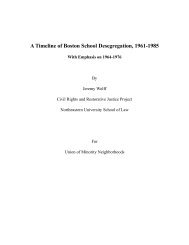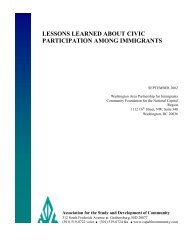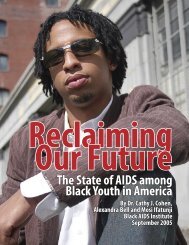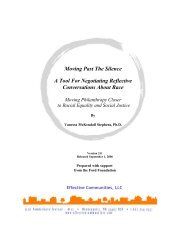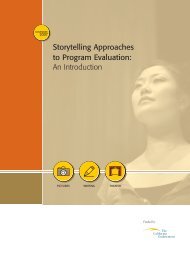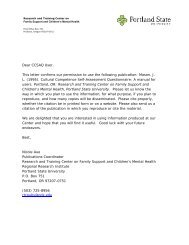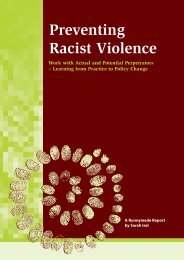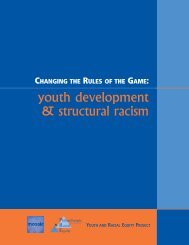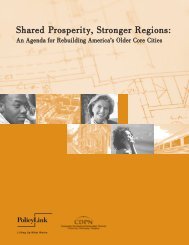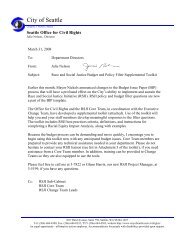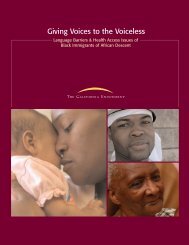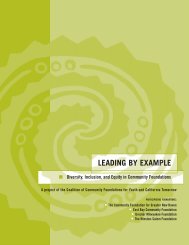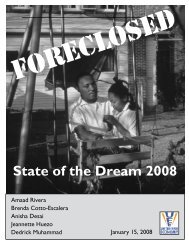REGIONAL OPPORTUNITYIII. D. BRIDGING SOCIAL,ECONOMIC, ANDGEOGRAPHIC DIVIDES:KENTUCKY’S COMMUNITYFARM ALLIANCEFunder Highlighted:Ford Foundation“Public markets can serve as eng<strong>in</strong>es <strong>of</strong> economicgrowth for urban <strong>and</strong> rural communities <strong>and</strong>therefore as regional bridges cross<strong>in</strong>g over theurban-rural divide.”— Miguel Garcia, Ford FoundationIt is an unfortunate fact that <strong>in</strong> a nation such as theUnited States, the lack <strong>of</strong> food security <strong>and</strong> accessrema<strong>in</strong>s a common struggle for low-<strong>in</strong>comecommunities. The struggles <strong>of</strong> disenfranchisedm<strong>in</strong>orities <strong>and</strong> the work<strong>in</strong>g poor are reflected by highrates <strong>of</strong> disease that could decrease with education<strong>and</strong> improved access to nutritious foods. This pr<strong>of</strong>ileillustrates the successful redef<strong>in</strong>ition <strong>of</strong> a farmers’market <strong>in</strong>to a vehicle for community revitalization<strong>and</strong> organiz<strong>in</strong>g where urban-rural <strong>and</strong> racial dividesare confronted <strong>and</strong> <strong>in</strong>creased equity is pursued.Project Pr<strong>of</strong>ileIn 2000, the state <strong>of</strong> Kentucky received $3.4 billion<strong>in</strong> tobacco settlement dollars. Given directly to thestate, <strong>and</strong> under the control <strong>of</strong> the Governor’s Office,these funds <strong>in</strong>spired considerable debate regard<strong>in</strong>gtheir use <strong>and</strong> the potential recipients. TheCommunity Farm Alliance, a group with a history <strong>of</strong>organiz<strong>in</strong>g <strong>and</strong> policy work, advocated for mak<strong>in</strong>gdollars available to help family farmers transition out<strong>of</strong> the tobacco economy that accounts for roughlyone-third <strong>of</strong> a typical farm’s <strong>in</strong>come. At the sametime, the Alliance successfully proposed that fundgovernance happen at the local level, with localcommunities sett<strong>in</strong>g their own goals for their fundallocations. This proposal provided an <strong>in</strong>itial fund<strong>in</strong>gbase to change the way family farms did bus<strong>in</strong>ess.Located <strong>in</strong> Kentucky, the Community Farm Alliance(CFA) is, “A statewide grassroots organization <strong>of</strong>persons committed to family-scale farm<strong>in</strong>g as themost efficient <strong>and</strong> susta<strong>in</strong>able form <strong>of</strong> produc<strong>in</strong>g thebest quality food, while protect<strong>in</strong>g the environment<strong>and</strong> strengthen<strong>in</strong>g rural community life.” 47Family farmers needed to become entrepreneurs <strong>in</strong>order to survive. Agricultural markets were chang<strong>in</strong>g,<strong>and</strong> family farms needed to follow suit by identify<strong>in</strong>gnew customers/markets <strong>and</strong> develop<strong>in</strong>g products tomeet those customers’ needs. The Community FarmAlliance began work<strong>in</strong>g with its membership toidentify these new market opportunities. One keyopportunity was the city <strong>of</strong> Louisville, Ky., home toone million people—almost one-quarter <strong>of</strong> the state’stotal population.Community Farm Alliance members speak-out aga<strong>in</strong>st tax <strong>in</strong>centives for out<strong>of</strong>-statecorporations <strong>and</strong> conf<strong>in</strong>ed animal feed<strong>in</strong>g operations. (Source:Community Farm Alliance).Thus, <strong>in</strong> 2002, longtime CFA staff member <strong>and</strong>family farmer Ivor Chodkowski applied for a sixmonthCFA fellowship, an <strong>in</strong>ternally-<strong>of</strong>fered sixmonthleadership development opportunity.Chodkowski’s fellowship proposal focused onidentify<strong>in</strong>g connections through conversations <strong>in</strong>Louisville <strong>and</strong> with farmers <strong>in</strong> adjacent ruralcommunities for jo<strong>in</strong>t economic opportunities. Thiseffort led him to the Portl<strong>and</strong> neighborhood.Western Louisville’s 12 neighborhoods, which<strong>in</strong>clude Portl<strong>and</strong>, are disproportionately low-<strong>in</strong>come,with 38 percent <strong>of</strong> the residents liv<strong>in</strong>g <strong>in</strong> poverty, <strong>and</strong>home to disproportionately high numbers <strong>of</strong> AfricanAmericans. One major equity issue that became clearto Chodkowski was that the residents <strong>of</strong> westernLouisville lack access to healthy <strong>and</strong> nutritious foods.For example, there are 105 grocery stores <strong>in</strong>Louisville, a ratio <strong>of</strong> one grocery for every 6,100Louisville residents. But the circumstances <strong>in</strong> these47www.communityfarmalliance.org/about.htm/.107Funders’ Network for Smart Growth <strong>and</strong> Livable Communities
12 western Louisville neighborhoods are verydifferent: there are four grocery stores total <strong>in</strong> theseneighborhoods, a ratio <strong>of</strong> one grocery for every19,431 residents. Thus, residents must either travellong distances for quality foods, or must purchasemore expensive food at one <strong>of</strong> 24 local conveniencestores. Furthermore, <strong>of</strong> these 24 stores, only six soldall five basic food groups <strong>and</strong> the only vegetables<strong>of</strong>fered were potatoes <strong>and</strong> onions. With diets low <strong>in</strong>healthy <strong>and</strong> nutritious foods, these 12 neighborhoodssee excessive rates <strong>of</strong> heart disease <strong>and</strong> cancer. In2002, there was not a s<strong>in</strong>gle farmers’ market <strong>in</strong> any<strong>of</strong> these 12 neighborhoods. As a result, Chodkowskibegan dialogues with Portl<strong>and</strong> residents aboutstart<strong>in</strong>g a farmers’ market <strong>in</strong> their neighborhood.In 2003, the Ford Foundation awarded a one-year$300,000 grant to the Community Farm Alliance <strong>in</strong>order to plan the Portl<strong>and</strong> Farmers’ Market <strong>and</strong> todevelop a long-term strategy around food security<strong>and</strong> new markets for farm products. On June 21,2003, the Portl<strong>and</strong> Farmers’ Market opened <strong>in</strong> thepark<strong>in</strong>g lot <strong>of</strong> a local pr<strong>in</strong>t<strong>in</strong>g bus<strong>in</strong>ess. Today, freshproduce, grown by local family farmers, is <strong>of</strong>fered,such as fruits, vegetables, plants, as well as naturalfree-range eggs <strong>and</strong> meats. In keep<strong>in</strong>g with the goal<strong>of</strong> provid<strong>in</strong>g Portl<strong>and</strong> neighborhood residents withaccess to healthy <strong>and</strong> nutritious foods, the Market’svendors accept Electronic Benefits Transfer (EBT)cards (food stamps). Additionally, the Market’svendors also accept coupons from the Rowan StreetCo-op, another CFA effort to make nutritious foodsavailable to seniors on fixed-<strong>in</strong>comes.Funder InterestThe Ford Foundation’s Active Public Space Initiativeattempts to forge common community <strong>in</strong>stitutionswith<strong>in</strong> emerg<strong>in</strong>g mixed-<strong>in</strong>come <strong>and</strong> mixed-racecommunities by support<strong>in</strong>g four categories <strong>of</strong>grantees: neighborhood arts <strong>and</strong> cultureorganizations, community technology centers, openspace <strong>and</strong> recreation programs, <strong>and</strong> public markets.The Initiative wanted to allocate some <strong>of</strong> its fund<strong>in</strong>gtoward economic development activities <strong>and</strong> wastry<strong>in</strong>g to identify a public spaces-focused economicdevelopment effort. Through such an effort, theFoundation would strengthen the case that publicmarkets could become economic eng<strong>in</strong>es support<strong>in</strong>gadjacent community revitalization.Ultimately, social justice considerations conv<strong>in</strong>cedthe Ford Foundation to provide a grant to theCommunity Farm Alliance. Accord<strong>in</strong>g to MiguelGarcia, act<strong>in</strong>g deputy director <strong>of</strong> the Community<strong>and</strong> ResourceDevelopment Unitat the FordFoundation, CFAprovided anopportunity tocreate practical,mutually beneficiall<strong>in</strong>kages amongrural/largely whitecommunities <strong>and</strong>urban/largely black communities, <strong>and</strong> also <strong>of</strong>fered astrong opportunity for collaborative learn<strong>in</strong>g for theproject’s participants <strong>and</strong> for the Foundation.<strong>Regional</strong>/Neighborhood Equity ImpactsThe Ford Foundation recognizes that any oneneighborhood (urban or rural) is l<strong>in</strong>ked with manyother neighborhoods as a part <strong>of</strong> a regional economic<strong>and</strong> social justice system. When these l<strong>in</strong>kages arerecognized <strong>and</strong> supported, a neighborhood’s residents<strong>and</strong> <strong>in</strong>stitutions start look<strong>in</strong>g beyond theirneighborhood <strong>and</strong> make broader policy decisions.Mutual opportunities <strong>and</strong> partnerships can becreated, overcom<strong>in</strong>g a rural versus urban m<strong>in</strong>dsetwhich pits these communities aga<strong>in</strong>st one another tocompete over f<strong>in</strong>ite resources.ResultsBuild<strong>in</strong>g practical connectionsbetween rural <strong>and</strong> urbanconstituencies, which so<strong>of</strong>ten entail connect<strong>in</strong>gwhites with people <strong>of</strong> colorcommunities, is fundamentalto regional equity.Accord<strong>in</strong>g to Ford’s Garcia, several results emergedfrom the Community Farm Alliance <strong>and</strong> its<strong>in</strong>volvement <strong>in</strong> the Portl<strong>and</strong> Farmers’ Market.Build<strong>in</strong>g practical connections between rural <strong>and</strong>urban constituencies, which so <strong>of</strong>ten entailconnect<strong>in</strong>g whites with people <strong>of</strong> color communities,is fundamental to regional equity. Ford saw anopportunity to build such l<strong>in</strong>kages with CFA <strong>and</strong> thePortl<strong>and</strong> Farmers’ Market.Many <strong>in</strong>ner-city communities lack access toaffordably priced fresh <strong>and</strong> healthy foods. Thus, thesecommunities must <strong>of</strong>ten resort to unhealthy <strong>and</strong>high-cost foods <strong>of</strong>fered at fast food outlets <strong>and</strong>convenience stores. These dietary habits contributeto high rates <strong>of</strong> diabetes, obesity, <strong>and</strong> other negativeREGIONAL OPPORTUNITYPart III: Section 3: Connect<strong>in</strong>g to <strong>Regional</strong> Opportunity 108
- Page 1 and 2:
Stories of Philanthropic Leadership
- Page 3 and 4:
Signs of Promise:Stories of Philant
- Page 5 and 6:
Funders’ Network for Smart Growth
- Page 7 and 8:
(II. B.)(II. C.)Turning Neighborhoo
- Page 9 and 10:
PART I:IntroductionThe Purpose of t
- Page 11 and 12:
social justice issues as they relat
- Page 13 and 14:
PART II:Perspectives on Advancing R
- Page 15 and 16:
peer work, we can reestablish a sig
- Page 17 and 18:
Annie E. Casey FoundationBaltimore,
- Page 19 and 20:
neighborhoods into healthy ones—g
- Page 21 and 22:
Charles and Helen Schwab Foundation
- Page 23 and 24:
Section 1:Promoting Equitable Publi
- Page 25 and 26:
I. A. BUILDING POWER AND GIVINGVOIC
- Page 27 and 28:
policy advocates. In 2002, Milwauke
- Page 29 and 30:
in Los Angeles, Ford’s Anthony no
- Page 31 and 32:
I. B. PROMOTING COALITIONSTO ADVANC
- Page 33 and 34:
Yet the interpersonal dynamics of c
- Page 35 and 36:
guidelines. “Many of the member o
- Page 37 and 38:
Funder InterestThe EPA supported th
- Page 39 and 40:
I. D. DEMONSTRATING THESTRUGGLE FOR
- Page 41 and 42:
Richmond, Calif.The second regional
- Page 43 and 44:
through policy reform at the local
- Page 45 and 46:
I. E. BUILDING COALITIONTHROUGH KNO
- Page 47 and 48:
organizing project, the Connecticut
- Page 49 and 50:
and businesses are quantified in a
- Page 51 and 52:
I. G. REVITALIZING WHILEASSURING DI
- Page 53 and 54:
In the late 1990s, the city of Albu
- Page 55 and 56:
I. H. A TRAVEZ DE LA FRONTERA:LAND
- Page 57 and 58:
The International Community Foundat
- Page 59 and 60:
I. I. MOBILIZING ACTION FORREGIONAL
- Page 61 and 62:
To meet all of these objectives, th
- Page 63 and 64: efforts. And with each public plann
- Page 65 and 66: pattern of disproportionate transpo
- Page 67 and 68: Clinica de la Raza identify this cr
- Page 69 and 70: Contact PeopleCarl AnthonyActing Di
- Page 71 and 72: Section 2:Making All Neighborhoods
- Page 73 and 74: II. A. REACHING BEYONDHOUSING TO IM
- Page 75 and 76: A local resident receives the keys
- Page 77 and 78: East Baltimore community and the Jo
- Page 79 and 80: example, adjacent to the EBDI area,
- Page 81 and 82: II. C. YIELDING REGIONALBENEFITS TH
- Page 83 and 84: is using transit-oriented developme
- Page 85 and 86: financing and innovative, forward-t
- Page 87 and 88: The Row House Community Development
- Page 89 and 90: II. E. COUNTERING THE PERFECTSTORM:
- Page 91 and 92: funded community programs, includin
- Page 93 and 94: housing developments and commercial
- Page 95 and 96: owned enterprises, totaling $8.5 mi
- Page 97 and 98: LOAN GUARANTEESSection 3:Connecting
- Page 99 and 100: III. A. MAKING HOUSING ANOPPORTUNIT
- Page 101 and 102: A new report from the National Hous
- Page 103 and 104: The Straphangers Campaign was found
- Page 105 and 106: Funder InterestThe Straphangers Cam
- Page 107 and 108: or increase poverty. Whether direct
- Page 109 and 110: The Regional Plan Association then
- Page 111 and 112: multi-stakeholder effort composed o
- Page 113: director with LISC. No one set of s
- Page 117 and 118: III. E. UNITING THREE STATESFOR ONE
- Page 119 and 120: increased their personal wealth by
- Page 121 and 122: summary evaluation of MSDI found th
- Page 123 and 124: method alone was strong enough to m
- Page 125 and 126: consistent body of work. The Counci
- Page 127 and 128: 3) Issues Need to be ConnectedThe f
- Page 129 and 130: PART V:Glossary of TermsThe terms d
- Page 131 and 132: Regional and neighborhood equity. A
- Page 133 and 134: Tijuana River Reserve, California:h
- Page 135 and 136: Sargent Shriver National Center on
- Page 137: 1500 San Remo Avenue • Suite 249



